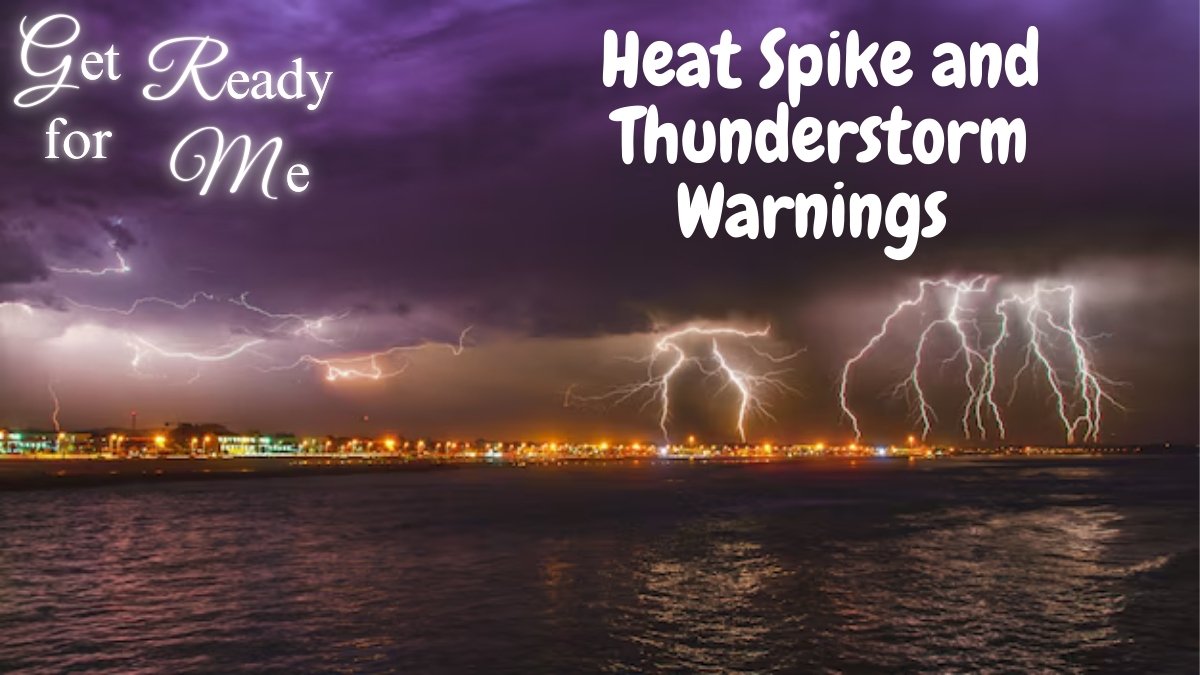The weather in the United Kingdom is notoriously unpredictable, but even by British standards, the combination of a sudden heat spike and looming thunderstorms presents a unique challenge. With meteorologists issuing warnings of intense thunderstorms following a period of unusually high temperatures, the public is urged to be vigilant and prepared. These sudden weather changes can have significant impacts on daily life, infrastructure, and even public health.
In this comprehensive guide, we will explore the phenomenon of thunderstorms following heat spikes in the UK. We will delve into the causes of these weather patterns, their potential effects, and the safety measures you can take to protect yourself and your property. Whether you’re a seasoned weather enthusiast or someone simply looking to stay safe during extreme weather, this article will provide you with the knowledge you need.
The UK’s heat spike and thunderstorms: What It Is and Why It Happens
Understanding heat spike and thunderstorms
A heat spike refers to a sudden and significant increase in temperature over a short period, often lasting a few days before temperatures return to more typical levels. These spikes can occur due to a variety of meteorological factors, including the arrival of warm air masses from the continent, high-pressure systems that trap heat, and changes in wind patterns.
In the UK, heat spikes are relatively rare but can be intense when they occur. The country’s temperate climate typically sees moderate summers, but in recent years, heat spikes have become more common due to climate change. These events can push temperatures well above average, leading to uncomfortable and sometimes dangerous conditions.
The Role of Climate Change
Climate change is a key factor in the increasing frequency and intensity of heat spikes in the UK. As global temperatures rise, weather patterns become more erratic, leading to more extreme weather events, including heatwaves and heat spikes. The UK, like many other countries, is experiencing the effects of a warming planet, with higher temperatures becoming the norm during the summer months.
This shift not only increases the likelihood of heat spikes but also enhances the potential for severe weather events, such as thunderstorms, to follow. Warmer air can hold more moisture, which can fuel powerful storms when the conditions are right.
The Impact of Heat Spikes on Daily Life
Heat spikes can have a profound impact on daily life in the UK. The sudden rise in temperatures can lead to heat-related illnesses, strain on public services, and disruption to transportation and infrastructure. For vulnerable populations, such as the elderly and those with pre-existing health conditions, a heat spike can pose serious health risks.
In addition to health concerns, heat spikes can also affect the economy. Increased demand for electricity due to air conditioning and cooling needs can strain the power grid, while businesses may face challenges in maintaining normal operations due to the heat. Agricultural sectors can also suffer, as crops may be damaged by the extreme temperatures.
Thunderstorm Warnings: What to Expect
What Triggers Thunderstorms After a Heat Spike?
Thunderstorms are often triggered by the atmospheric instability created by a heat spike. When the hot air at the surface rises and meets cooler air in the upper atmosphere, it can create the perfect conditions for thunderstorms to develop. The process is further enhanced if there is sufficient moisture in the air, which can lead to the formation of large storm clouds, known as cumulonimbus clouds.
In the UK, thunderstorms following a heat spike are often intense but short-lived. These storms can bring heavy rain, lightning, strong winds, and sometimes hail. The rapid development and movement of these storms mean that they can catch people off guard, leading to dangerous situations, particularly if people are not prepared.
Types of Thunderstorm Warnings Issued
When thunderstorms are expected, the UK’s Met Office issues warnings to help the public prepare. These warnings are typically color-coded based on the severity and potential impact of the storm:
- Yellow Warnings: Indicate that severe weather is possible but not guaranteed. People should stay informed and be aware of changing conditions.
- Amber Warnings: Suggest that severe weather is more likely, with a potential for disruption and danger to life and property. Preparation is advised.
- Red Warnings: Signal that severe weather is expected, with a high risk of significant impacts. Immediate action should be taken to ensure safety.
These warnings are crucial for helping people understand the risks and take appropriate measures to protect themselves and their property. They are typically issued in advance but can be updated as the situation develops.
Potential Impacts of heat spike and thunderstorms in the UK
Thunderstorms following a heat spike can lead to a range of impacts, both immediate and long-term. Some of the most common effects include:
- Flooding: Heavy rain can lead to flash flooding, particularly in urban areas where drainage systems may be overwhelmed. This can cause significant damage to homes, businesses, and infrastructure.
- Power Outages: Lightning strikes and strong winds can damage power lines, leading to outages. In some cases, these outages can last for several hours or even days, depending on the severity of the damage.
- Transportation Disruption: Thunderstorms can cause delays and cancellations in transportation services, particularly for trains and flights. Roads may also become hazardous due to flooding or debris.
- Property Damage: Strong winds, hail, and lightning can cause damage to buildings, vehicles, and other property. In severe cases, this can result in costly repairs and insurance claims.
- Health Risks: Thunderstorms can exacerbate respiratory issues due to changes in air quality, and the combination of heat and humidity can lead to heat exhaustion or heatstroke.
Preparing for Thunderstorms During a Heat Spike
Monitoring Weather Reports
The first step in preparing for thunderstorms during a heat spike is to stay informed. Regularly check weather reports from reliable sources, such as the Met Office, to stay updated on the latest forecasts and warnings. Mobile apps and websites can provide real-time alerts, ensuring that you have the most current information.
It’s also important to understand the different types of warnings and what they mean. Knowing whether a yellow, amber, or red warning has been issued can help you gauge the severity of the situation and take appropriate actions.
Protecting Your Home and Property
To protect your home and property during a thunderstorm, there are several steps you can take:
- Secure Loose Items: Strong winds can turn outdoor furniture, garden tools, and other loose items into dangerous projectiles. Secure these items or bring them indoors before the storm hits.
- Check Your Roof and Gutters: Ensure that your roof is in good condition and that gutters are clear of debris. This will help prevent water damage and reduce the risk of flooding.
- Install Surge Protectors: Lightning strikes can cause power surges that damage electronic devices. Installing surge protectors can help safeguard your electronics.
- Trim Trees and Shrubs: Overhanging branches can break off during a storm and cause damage to your home or vehicle. Regularly trim trees and shrubs to reduce this risk.
Preparing an Emergency Kit
Having an emergency kit on hand is essential for dealing with the aftermath of a thunderstorm. Your kit should include:
- Flashlights and Batteries: Power outages are common during thunderstorms, so make sure you have a reliable source of light.
- Non-Perishable Food and Water: In case you are unable to leave your home, have enough food and water to last for at least three days.
- First Aid Supplies: Include bandages, antiseptics, medications, and other basic medical supplies.
- Battery-Powered Radio: A radio can help you stay informed if the power goes out and you lose access to mobile devices or the internet.
- Important Documents: Keep copies of important documents, such as insurance policies and identification, in a waterproof container.
Staying Safe During the Storm
During a thunderstorm, it’s important to prioritize your safety. Here are some tips to stay safe:
- Stay Indoors: The safest place to be during a thunderstorm is indoors. Avoid going outside unless absolutely necessary.
- Avoid Using Electrical Appliances: Lightning can travel through electrical wiring, so avoid using appliances or touching electrical outlets during a storm.
- Stay Away from Windows: Strong winds and flying debris can shatter windows, so stay away from them during the storm.
- Unplug Electronics: To protect your devices from power surges, unplug them before the storm arrives.
- Avoid Water: Do not take a shower, bath, or use running water during a thunderstorm, as lightning can travel through plumbing.
Responding to Emergencies
If a thunderstorm causes an emergency, such as flooding or property damage, it’s important to respond quickly and calmly. Here’s what to do:
- Contact Emergency Services: If you or someone else is in immediate danger, call 999 or the appropriate emergency number.
- Evacuate if Necessary: If your home is at risk of flooding or structural damage, evacuate to a safe location as directed by authorities.
- Document Damage: If it is safe to do so, document any damage to your property with photos or videos for insurance purposes.
- Check on Neighbors: After the storm has passed, check on neighbors, particularly those who are elderly or vulnerable, to ensure they are safe.
The Science Behind Thunderstorms and Heat Spikes
How Thunderstorms Form
Thunderstorms form when warm, moist air rises and cools, leading to the condensation of water vapor into clouds. As the air continues to rise, the clouds grow larger and can develop into cumulonimbus clouds, which are the hallmark of thunderstorms.
The energy that drives a thunderstorm comes from the heat released when water vapor condenses into liquid droplets. This process creates an updraft, which pulls more warm air into the storm, fueling its growth. If the conditions are right, the storm can become severe, with strong winds, heavy rain, lightning, and sometimes hail or tornadoes.
The Role of Atmospheric Instability
Atmospheric instability is a key factor in the development of thunderstorms. Instability occurs when warm air near the surface is overlain by cooler air aloft. This temperature difference creates a situation where the warm air wants to rise, leading to the development of strong updrafts.
During a heat spike, the surface temperature can rise rapidly, increasing the amount of warm air available to fuel thunderstorms. If this warm air is moist, it can lead to the formation of powerful storms once it begins to rise and cool.
The Connection Between heat spike and thunderstorms
Heat plays a crucial role in the formation of thunderstorms. As temperatures rise during a heat spike, more energy is available in the atmosphere, which can lead to more intense storms. Additionally, the warmer air can hold more moisture, which can lead to heavier rainfall when thunderstorms do occur.
The combination of heat and humidity during a heat spike creates the perfect conditions for thunderstorms to develop. This is why thunderstorms often follow periods of extreme heat, as the atmosphere tries to release the built-up energy.
Predicting heat spike and thunderstorms: The Role of Meteorologists
Predicting thunderstorms involves monitoring a range of meteorological factors, including temperature, humidity, wind patterns, and atmospheric pressure. Meteorologists use advanced technology, such as radar and satellite imagery, to track these conditions and forecast where and when thunderstorms are likely to occur.
In the UK, the Met Office plays a crucial role in monitoring and predicting thunderstorms. By analyzing weather data and using computer models, meteorologists can issue warnings and provide the public with the information they need to stay safe.
The Impact of heat spike and thunderstorms on Infrastructure and Society
Transportation Disruptions in heat spike and thunderstorms
Thunderstorms can cause significant disruptions to transportation networks. Heavy rain can lead to flooding on roads, making them impassable or hazardous. Strong winds can blow debris onto train tracks, causing delays or cancellations, while lightning strikes can disrupt signals and power supplies.
Air travel is also affected by thunderstorms. Lightning, turbulence, and strong winds can lead to flight delays or cancellations, stranding passengers at airports. In severe cases, airports may even shut down temporarily due to safety concerns.
Power Outages and Electrical Infrastructure
One of the most common impacts of thunderstorms is power outages. Lightning strikes can damage power lines and transformers, leading to widespread outages. In some cases, the strong winds associated with thunderstorms can bring down power lines or cause trees to fall onto them, exacerbating the problem.
Restoring power after a thunderstorm can take time, particularly if the damage is extensive or if access to the affected areas is limited. During a heat spike, power outages can be particularly problematic, as they can leave people without air conditioning or fans, increasing the risk of heat-related illnesses.
Flooding and Water Damage
Flooding is a major concern during thunderstorms, especially if the ground is already saturated from previous rain or if the storm produces a large amount of rainfall in a short period. Urban areas are particularly vulnerable to flooding, as the drainage systems may not be able to cope with the sudden influx of water.
Flooding can cause extensive damage to homes, businesses, and infrastructure. It can also disrupt transportation and access to essential services. In severe cases, floodwaters can contaminate drinking water supplies, leading to health risks.
Economic Impacts
The economic impacts of thunderstorms following a heat spike can be significant. Businesses may suffer losses due to closures, property damage, or disruptions to supply chains. The cost of repairing damage to infrastructure, such as roads, bridges, and power lines, can also be substantial.
In the agricultural sector, thunderstorms can damage crops, particularly if they are accompanied by hail or strong winds. This can lead to reduced yields and financial losses for farmers.
Health Risks and Public Safety
Thunderstorms during a heat spike can pose a range of health risks. The combination of high temperatures and high humidity can lead to heat exhaustion or heatstroke, particularly if people lose access to cooling due to power outages. The elderly, young children, and those with pre-existing health conditions are particularly vulnerable.
Thunderstorms can also exacerbate respiratory conditions, such as asthma, due to changes in air quality and the presence of allergens like pollen. Additionally, the risk of injury from flying debris, falling trees, or lightning strikes is heightened during severe storms.
Public Response and Government Preparedness
Emergency Services and Response Plans
In the UK, emergency services play a critical role in responding to the impacts of thunderstorms. Firefighters, paramedics, and police are often the first on the scene when floods occur, roads are blocked by fallen trees, or people are injured by lightning.
Local councils and government agencies also have response plans in place to deal with the aftermath of severe weather. These plans may include setting up emergency shelters, distributing supplies, and coordinating clean-up efforts.
Government Warnings and Public Communication
The UK government, through the Met Office and other agencies, issues warnings and provides information to the public before and during thunderstorms. These warnings are disseminated through various channels, including television, radio, social media, and mobile apps.
Clear and timely communication is essential to ensure that the public understands the risks and takes appropriate actions to stay safe. This communication also includes guidance on what to do during power outages, flooding, or other emergencies.
Community Preparedness and Involvement
Community preparedness is an important aspect of dealing with the impacts of thunderstorms. Local communities can play a role in helping vulnerable individuals, such as the elderly or those with disabilities, prepare for and respond to severe weather.
Community groups and volunteers often step in to assist with clean-up efforts, distribute supplies, and provide support to those affected by storms. Building a sense of community resilience can help mitigate the impacts of severe weather and ensure that everyone is able to recover more quickly.
Long-Term Implications and Climate Change
The Future of Heat Spikes and Thunderstorms in the UK
As climate change continues to affect weather patterns, the UK is likely to experience more frequent and intense heat spikes and thunderstorms. These changes will have wide-ranging implications for public health, infrastructure, and the economy.
Preparing for the future means investing in infrastructure that can withstand extreme weather, such as flood defenses and resilient power grids. It also means enhancing public awareness and preparedness, so that people know how to stay safe and protect their property during severe weather events.
Adapting Infrastructure and Urban Planning
Adapting infrastructure to cope with more extreme weather is a key challenge for the UK. This includes upgrading drainage systems to prevent flooding, strengthening power grids to withstand storms, and ensuring that buildings are designed to stay cool during heat spikes.
Urban planning will also need to take into account the changing climate. This might involve creating more green spaces to absorb rainwater, designing buildings with better insulation, and planning for emergency shelters that can be used during heatwaves and storms.
The Role of Renewable Energy
As the UK transitions to renewable energy sources, such as wind and solar power, it will be important to ensure that these systems are resilient to extreme weather. For example, solar panels must be able to withstand hailstorms, and wind turbines need to be designed to cope with strong winds.
Investing in energy storage solutions, such as batteries, can also help ensure a reliable power supply during storms and reduce the impact of power outages on households and businesses.
Public Awareness and Education
Raising public awareness about the impacts of climate change and the importance of preparedness is essential. Education campaigns can help people understand the risks associated with heat spikes and thunderstorms and provide them with the knowledge they need to stay safe.
Schools, community groups, and local councils can all play a role in educating the public about severe weather and encouraging proactive measures, such as creating emergency kits and developing family emergency plans.
Global Perspective: Lessons from Other Countries
The UK is not alone in facing the challenges of extreme weather. Other countries, particularly those in tropical and subtropical regions, have extensive experience dealing with heatwaves and severe storms. Learning from these countries can provide valuable insights into how the UK can improve its preparedness and response to extreme weather.
For example, countries like Japan and the United States have developed sophisticated early warning systems and emergency response plans that could serve as models for the UK. Collaborating with international partners and sharing best practices can help the UK enhance its resilience to future weather events.
FAQs
What is a heat spike?
A heat spike refers to a sudden and significant increase in temperature over a short period, often lasting a few days before temperatures return to more typical levels.
How do thunderstorms form after a heat spike?
Thunderstorms often form after a heat spike due to the atmospheric instability created by the rising warm air at the surface, which meets cooler air in the upper atmosphere, leading to the development of storm clouds.
What are the risks of thunderstorms during a heat spike?
Risks include flooding, power outages, transportation disruptions, property damage, and health risks such as heat exhaustion and respiratory issues.
How can I stay safe during a thunderstorm?
To stay safe during a thunderstorm, stay indoors, avoid using electrical appliances, stay away from windows, unplug electronics, and avoid using running water.
What should I include in an emergency kit for thunderstorms?
An emergency kit should include flashlights and batteries, non-perishable food and water, first aid supplies, a battery-powered radio, and important documents in a waterproof container.
How does climate change affect heat spikes and thunderstorms?
Climate change increases the frequency and intensity of heat spikes and thunderstorms by altering weather patterns and increasing atmospheric instability.
Conclusion
The combination of a heat spike and thunderstorms presents a significant challenge for the UK, affecting everything from public safety and infrastructure to daily life and the economy. Understanding the science behind these weather events, staying informed through reliable sources, and taking proactive steps to protect yourself and your property are crucial for navigating these extreme conditions.
As the impacts of climate change continue to unfold, the UK will need to adapt and enhance its preparedness for future weather events. By investing in resilient infrastructure, raising public awareness, and learning from global best practices, the country can better withstand the challenges posed by heat spikes and thunderstorms. Whether you’re facing a sudden heat spike or the threat of a severe thunderstorm, staying informed and prepared is your best defense.












One thought on “Heat Spike and Thunderstorms Warnings as UK Faces”